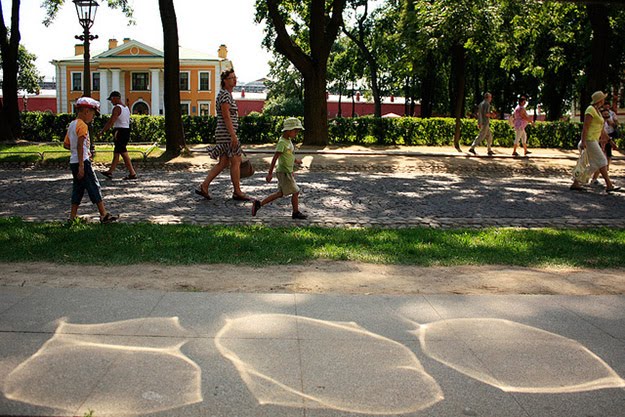New milling techniques applied to glass and plexiglass panels could be used to “create windows that are also cryptic projectors, summoning ghostly images from sunlight.”
 [Image: A piece of milled plexiglass acting as a projecting lens; via the Computer Graphics and Geometry Lab at the École Polytechnique Fédérale de Lausanne].
[Image: A piece of milled plexiglass acting as a projecting lens; via the Computer Graphics and Geometry Lab at the École Polytechnique Fédérale de Lausanne].
They do so by “taking control of a seemingly chaotic optical phenomena known as caustics,” in the words of New Scientist. Mark Pauly and Philippe Bompas have been experimenting with so-called “caustic engineering,” combining Pauly’s background in computational geometry and Bompas’s interest in manipulating otherwise “unintentional light shows produced by the reflection and refraction of light from curved mirrors or glass structures.” Indeed, Bompas’s work has a somewhat Neoplatonic overtone, as it involves “working backwards from a pattern of light to deduce the structure needed to create it.”
Working together, Pauly and Bompas—not Bompas and Parr—set out to fabricate “a large, transparent plate capable of generating a high-resolution image when a light was shone through it,” and they “chose to make the plate in perspex, which is easier to shape than glass.” You can see it in the image included in this post.
The architectural implications are obvious, and are brought to the fore by the New Scientist article from which I’m quoting. For instance: “Now [Pauly and Bompas] hope that the technique will be used in architectural design, to create windows that mould sunlight and throw images or patterns onto walls or floors,” which, if timed, milled, and manipulated just right, could produce a slowly animated sequence of images being projected by an otherwise empty window during different times of day. After all, “it should be possible to create a transparent plate containing several overlayed caustics that become visible as an animation as the light source moves.”
One piece of glass, infinitely dense with visual imagery, a kind of dream-prism casting slow two-hour films across the floor as the day goes by.
 [Image: Reflections off glass or other polished surfaces could be controlled—that is, manipulated into producing recognizable images or specific shapes—by way of “caustic engineering”; Creative Commons photo by Flickr user passer-by].
[Image: Reflections off glass or other polished surfaces could be controlled—that is, manipulated into producing recognizable images or specific shapes—by way of “caustic engineering”; Creative Commons photo by Flickr user passer-by].
This can work not only with light passing through milled transparent surfaces but with light bouncing off complexly shaped reflective surfaces—something the article describes as pieces of metal that look like “the mildly dented bodywork of a car” (i.e. parametric formalism in architecture today) creating recognizable images in the weird sprays of light they produce.
Curve a building just right with the daily passage of the sun, placing caustic windows at key moments so that their reflections or projections overlap like edits, and your building is now a cinema: an optical landmark with content, in the narrative life of the city. Buskers offer optional soundtracks. Reflection festivals arise on sidewalks. Milled glass objects play filmloops in the sun.

And it sounds like we are getting ever closer to achieving Bob Shaw's 'slow glass', through which the past can be seen.
Your reference to buildings brings to mind Walt Disney's Concert Hall in LA, which creates areas of relatively intense heat on nearby pavements thanks to its curved facades… See http://www.sbse.org/awards/docs/2005/1187.pdf
I can't wait to see an art installation complete with a solar collector making my boring sidewalks into something interesting. I am, however terrified that this will be a new path for advertising revenue, thus turning my commute to work into a long Twix or Pantene advert. 🙁